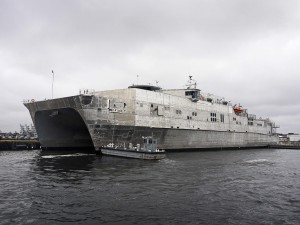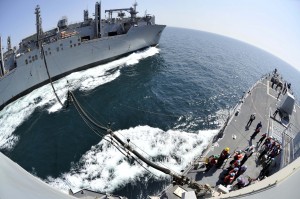2013-06-05 After the conclusion of the BOLD ALLIGATOR 2013 exercise, we had a chance to talk with Col Bradley Weisz, Deputy Commander for the ESG TWO, about the exercise and the way ahead.
Col Weisz provided some insights with regard to a number of activities in BOLD ALLIGATOR 2013, which had been either touched on lightly or not at all by participants interviewed earlier.
This helped round out the picture.
He also provided some thoughts on the way ahead for the next BOLD ALLIGATOR exercise.
SLD: One part of the innovations in BA 13 was the use of some new assets. One of these assets was the Joint High Speed Vessel (JHSV). Could you talk about how JHSV was used in the exercise?
Col Weisz: Sure, for starters, the Joint High Speed Vessel provides some great capabilities to the Navy-Marine Corps team. With the ability to go thirty-five plus (35+) knots, carry approximately three-hundred (300) Marines and Sailors as well as six-hundred (600) short-tons of cargo and equipment, we, the blue-green team, are very excited about this ship. It has a flight deck for rotary-wing operations and a very capable off-load ramp that will allow vehicles to quickly drive on and off the ship. Its shallow draft enhances littoral operations and port access. It is good to go!

For BOLD ALLIGATOR 13, we started with three primary uses for the Joint High Speed Vessel.
The first use was to quickly embark and transport some of the landing force’s personnel, equipment and cargo that would be supporting maritime operations throughout all of the littorals. We wanted to find a niche capability with the landing force and be able to fully exploit it in support of anti-access/area-denial (A2/AD) neutralization or roll-back operations.
Secondly, was the potential use of the JHSV as a medical evacuation platform. If we encountered significant casualties, these personnel would be brought aboard the Joint High-Speed Vessel and rapidly transported out to our sea base medical capabilities aboard our amphibious assault ships, the LHDs, or possibly even transported to a land based medical facility further in the rear area and completely out of harm’s way.
The third primary use was to stage critical amphibious task force supplies for future use in and around the amphibious objective area. Again, with the ability to steam at thirty-five plus (35+) knots, if you had a shortage of class 1 (food and water), class 3 (fuel) or class 5 (ammunition), the JHSV gives you the capability of getting those supplies and sustainment into the operation, into the fight, very quickly and efficiently.
Additionally, both the amphibious task force and the landing force were prepared to utilize the JHSV in support of humanitarian assistance/disaster relief (HA/DR) and non-combatant evacuation (NEO) operations, whatever those missions would have called for. Again, the intent was to develop a small but capable niche in support of the operation and exploit it rapidly and decisively.
But as the operation unfolded, a fifth use emerged for the Joint High Speed Vessel. The Navy expeditionary combat command, the NECC, requested it and utilized it to reposition some of their security forces and equipment within the operational area, utilizing several small ports to embark and debark their forces. As a result, these NECC assets helped protect the amphibious task force as well as provide security for the landing force when they came ashore.
So, as you can see, the Joint High Speed Vessel is an extremely flexible asset for supporting a wide range of operations including maneuver and sustainment, relief operations in small or damaged ports, flexible logistics support or as key enablers for rapid transport.
SLD: There is a key development, which can easily be missed in the evolution of the seabased logistics system, namely the role of RFID, and IT systems, which facilitate selective offloading. Could you talk about the importance of this capability in shaping expeditionary logistics capabilities?
Col Weisz: Sure can. You have to know exactly what gear and equipment is on your ship at all times and exactly where it is staged, where it is positioned at all times so you can conduct a rapid and organized off-load when required. It is called organization and you must have it aboard your ships.
Off-loading an entire ship just for a few items makes absolutely no sense at all. Trying to figure out where some gear and equipment is staged, where it is positioned aboard the ship can be very time consuming and ultimately delay operations ashore, not what the commander wants to do.
We use those RFID tags and IT systems to properly stage, position, track and off-load all gear, equipment and supplies aboard our ships, especially the T-AKEs. Those systems are critical for the rapid build-up of combat forces ashore in support of amphibious operations.
When you have all your gear, equipment and supplies completely organized and ready to go, it makes it that much easier to deliver the landing force ashore rapidly.
Yes, the RFID tags and IT systems are critical enablers for the landing force team. They are a must have.
SLD: The T-AKE ship has elevators, unlike its predecessor. This coupled with the new IT systems allows, the logistics team to be able to push forward the equipment and supplies demanded by the ashore force.

Col Weisz: That is a great point, you are exactly right. Elevators and IT systems may not seem essential, but when properly combined with an evolving and time sensitive CONOPS they become significant enablers. They truly enhance your rapid build-up of combat power ashore; they are also a must have.
SLD: Could you talk about the centrality of C2? In a world where acronyms abound, and folks now talk about C5ISR, the reality is that C2 is the central piece for an insertion force, especially coming from the sea and being air dropped. What are the challenges going forward with single naval battle in shaping appropriate C2?
Col Weisz: For me, if you get the C2 piece correct, everything else will just fall into place.
It all boils down to establishing and maintaining personal relationships, continuously engaging your partners, your subordinates and holding them accountable for their actions and support. The blue-green team in support of the single naval battle will only get better by continuing to train regularly with each other, trying to develop and improve our habitual relationships with each other. Effectively integrating the Expeditionary Strike Group, the Marine Expeditionary Brigade and the Carrier Strike Group can be easily accomplished; we just need to train, to engage each other more frequently than we have in the past.
SLD: Col Riccio spoke of the challenge of risk management with regard to ensuring that there are adequate supplies ashore to support the forces. When you are supporting from the seabase or using air dropping, it is a challenge to get it exactly right in terms of logistics support, and the negative consequences of not getting it right can be significant. What is your take on the risk management challenge?
Col Weisz: Well, the risk management challenge comes with all operations.
The commanders and their staffs definitely saw that there was a certain amount of risk out there.
We tried to mitigate that risk by deploying ashore only the minimum force necessary to accomplish the mission, no more.
So, in essence, we limited our footprint ashore and utilized our unique sea-basing capabilities to the maximum extent in supporting the forces ashore. The intent was to develop and maintain a robust and redundant sea-based logistics and sustainment system that could respond and deliver the goods, the requirements on a moment’s notice to the warfighter ashore. Basically, meet his requirements ashore just as he was requesting them.
SLD: The exercise provided a mix and match set of threats facing the force, which mirrors reality quite well, in that, the diversity of challenges is what makes operations difficulty. Could you talk about the diversity of challenges issue in the exercise?
Col Weisz: You’re right, it does mirror our current operating environment quite well.
The very first threat that we dealt with was an anti-access/area-denial threat. We had to concentrate and focus heavily on how to quickly neutralize, to take out that A2/AD threat in order for us just to get into the operational area. We had to neutralize his coastal defense cruise missile (CDCM), anti-ship cruise missile (ASCM), surface-to-air (SAM) and sea mine capabilities very quickly.
Once we started operating in the amphibious objective area, we had to deal with more conventional threats from the air, surface and sub-surface domains. Fast movers, surface action groups and diesel submarines had to be dealt with by the blue-green team.
Finally, once the landing forces went ashore, they faced both conventional and asymmetric threats from violent extremist organizations, that created numerous challenges for the Marines and Sailors. While all this was taking place, the amphibious task force and landing force was also fully prepared to provide humanitarian assistance/disaster relief and non-combatant evacuation support if needed by the maritime component commander.
SLD: It is the 21st century version of the three-block war!
Col Weisz: You are exactly right.
It is the 21st Century version of a three-block war.
A2/AD, followed by conventional warfare with asymmetric warfare also thrown in, while being fully prepared and ready to provide HA/DR support.
SLD: What are some of the things going forward that will play out in BA-14?
Col Weisz: We clearly want to keep the partnership between ESG 2 and 2nd MEB strong. Without a doubt, this year’s exercise cemented that close partnership even more.
We want to continue integrating the carrier strike group in support of amphibious and expeditionary operations. This is critical for the single naval battle concept. This year there was a great working relationship that existed between the ESG, the MEB and the CSG.
We need to continue integrating coalition forces and capabilities into the exercise; this is an absolute must. Our coalition partners provide outstanding leadership and experience in amphibious and expeditionary operations. We must continue to learn from them as much as we possibly can.
Finally, we need to continue working on and refining our communications strategy.
It is clear that in this type of operation, the littoral version of the three-block war, communications strategy is absolutely crucial for the success of the force.
We need to do much more in this key area of influence

